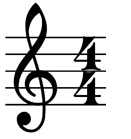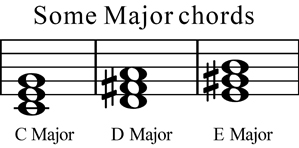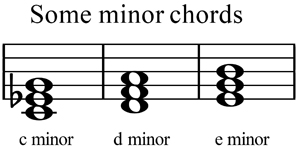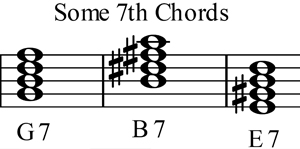Harmony is a subject from Conservatoire that studies chords: their formation and the relation between them. Chords are gropus of notes that are played at the same time and are separated from each other by certain distances (that are measured in tones and semi-tones) complying with some specified established rules to form the different kinds of chords that exist such as major, minor, 5 chords, etc...
Major chords sound lively, on the contrary minor chords are sad: all this depends on the qualities of the several types of chords like, the intervals (the distances between the notes that form them) and also the number of different notes that chords have, if they are major or minor they have 3 different notes (for example C Major is form by the notes c, e and g).


These notes can be repited within the chord and be played all at the same time. For example guitars have got 6 strings so you can play a chord repeating some of the notes that form it or all of them. This is the particular case of the well known "guitar's accompaniment chords" that people use to sing songs and use to have 6 notes for that reason, because the different notes that chords have are repeated, for example in E Major you play three e, two b and one g sharp, in e minor is the same but g is not sharp. But the notes don't have to be repeated in the chords, this only happens sometimes like for example in those guitar's standard chords that are use for accompaniment in songs with established positions for the left hand. In fact you could play just three strings with the 3 different notes of the chord, or you could also play them higher or lower or in different order.

It's very common to repeat just the note that gives the name to the chord; like in E Major e, or in A major a, etc... so there are four notes because one of them is repeated one octave higher, for example. In the 7 chords there are 4 different notes like in A 7 (a, c sharp, e and g) the standard chord would be two a, one c sharp, and 3 e. There are more types of chords and many other things to explain about them.

But why chords were formed like that, major chords in particular?
More things about chords.One of the most important things to distinguish in music are the melody and chords. If we classify chords excessively, without considering the melody goes through them producing foreign notes, we "break" music since the melody sentence, which is the main pattern, looses sense. Sometimes instead of complicated chord names, it's better to say that a "C Major" has a "strange note" (an "f" for example) that is not from the chord but part of the melody since it gives more sense to music.
Following on from the foregoing there are several basics that should be added. But it must be understood that it's very dificult to learn music without a teacher and therefore all these explanations may be confused because they are not for the first day class, they are learned in Conservatoire for years. This is only a little part of everything there is to know about Harmony; it's a first contact as fun as possible in order to motivate the reader to learn music but probably you may need to go deeper in all this topics. Even so, if you are interested in Harmony in this website you can read another article about the tonality and tonic, dominant and subdominant chords.
More recommendations:In this website you can learn to tune your guitar, to change the strings and put new ones, you can also read some useful and basic tips if you are going to buy a guitar or take better care of yours. You can also find information about the guitar lessons that Miguel Angel González Aguado offers. If you don't live in Madrid you can take guitar lessons online from any part of the World.